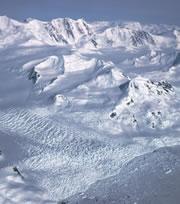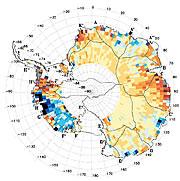 East Antarctica may be piling on the pounds, but glaciers in the west are accelerating into the ocean.© British Antarctic Survey
East Antarctica may be piling on the pounds, but glaciers in the west are accelerating into the ocean.© British Antarctic SurveyIncreased snowfall over a large area of Antarctica is thickening the ice sheet and slowing the rise in sea level caused by melting ice.
A satellite survey shows that between 1992 and 2003, the East Antarctic ice sheet gained about 45 billion tonnes of ice - enough to reduce the oceans' rise by 0.12 millimetres per year. The ice sheets that cover Antarctica's bedrock are several kilometres thick in places, and contain about 90% of the world's ice. But scientists fear that if they melt in substantial quantities, this will swell the oceans and cause devastation on islands and coastal lands.
“It is the only large terrestrial ice body that is gaining mass rather than losing it.”
Curt Davis
University of Missouri, Columbia
The Intergovernmental Panel on Climate Change (IPCC) has reported that sea level is currently rising at about 1.8 millimetres per year, largely through melting of the Greenland and Antarctic ice sheets as a result of global warming. But the panel also expected that climate change would trigger an increase in snowfall over the Antarctic continent, as increased evaporation from the oceans puts more moisture into the air.
"This is a phenomenal piece of research, but it is what we expected, " comments David Vaughan, a glaciologist at the British Antarctic Survey in Cambridge, UK. "These effects have been predicted for a long time, it's just that no one has measured them before."
Although the results of the satellite survey are in line with the predictions of global-warming models, the thickening of the ice sheet could still be explained by natural weather variability, warns Curt Davis of the University of Missouri, Columbia, a member of the research team. He and his colleagues present their results in the online edition of Science1.
Remote view
 This map shows which areas of Antarctica are thickening.© Science
This map shows which areas of Antarctica are thickening.© ScienceThe team used data from the European Space Agency's radar satellites ERS-1 and ERS-2, which measured changes in altitude over about 70% of Antarctica's interior - more than 8.5 million square kilometres, roughly the same size as the United States.
East Antarctica thickened at an average rate of about 1.8 centimetres per year over the time period studied, the researchers discovered. The region comprises about 75% of Antarctica's total land area - but as its ice is thicker, it carries about 85% of the total ice volume. "It is the only large terrestrial ice body that is gaining mass rather than losing it," says Davis.
In contrast, smaller West Antarctica showed an overall thinning of 0.9 centimetres per year. "It's amazing that they can measure such small changes," says Vaughan.
Thick skin
The thickening of the eastern ice sheet should not be seen as a long-term protection against a rise in sea level, warns Vaughan. Glaciers in West Antarctica are accelerating, releasing more and more icebergs into the sea. And the Antarctic Peninsula, which stretches towards South America, now regularly hits temperatures above 0 °C in the summer, leading to direct melting of the ice there.
What's more, snowfall over East Antarctica will not continue to increase indefinitely in a warming world, Vaughan adds. Conversely, every extra degree of temperature rise will continue to accelerate glaciers and cause more melting on the western side of Antarctica, swelling the world's oceans further.
ADVERTISEMENT
Scientists have already estimated that Antarctic melting may be responsible for up to a third of the overall sea-level rise. But the instruments on ERS-1 and 2 only work over very flat areas, and tend to lose track of the radar echo over steeper areas around the continent's coast, so a vital piece of the puzzle is still missing, says Vaughan. And because Antarctica is so vast, it is also impossible to measure snowfall comprehensively on the ground, he adds.
However, the European Space Agency satellite CryoSat, due to be launched later this year, should be able to make very accurate altitude measurements around the coast, providing evidence of exactly how much ice is being lost there. Only when scientists put all these measurements together will the full truth about Antarctica's ice become clear, says Vaughan.
University of Missouri, Columbia
